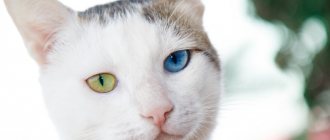Cold ears in a pet - the main reasons
The main reason for the alarming manifestation is that under the thick fur coat there are almost no glands that secrete sweat. Thanks to this feature, excess heat that accumulates in the body is removed through the least fur-covered areas. This is usually the ears, although heat can also escape through the pads of the feet or even the nose.
Short-haired animals often suffer from hypothermia, especially if the temperature in the apartment is not too high. The animal begins to hide under a blanket or cuddle up to a warm radiator. If there are no other signs of illness, it is recommended to dress your pet in overalls or arrange a home near a heat source.
Veterinarians warn that a cat’s cold ears often indicate pregnancy. This is one of the manifestations of toxicosis, from which your pet often suffers.
The last cause of alarm is a serious illness. During the examination, it is also recommended to pay attention to the shade - if the skin becomes light or bluish, immediately go to the veterinarian. This symptom often signals the development of diseases of the cardiovascular system.
Pathological conditions
Cold paws can also indicate a number of diseases or pathological conditions. Thus, persistent coldness of the extremities is observed:
- In the postoperative period upon recovery from anesthesia. This is why veterinarians recommend keeping an unconscious cat on a heating pad even on a summer day.
- Due to external or internal bleeding, since blood loss leads to a decrease in circulating blood volume.
- When dehydrated. Severe diarrhea and vomiting can lead to disruption of the water-salt balance in the body and thickening of the blood. To stabilize the condition, urgent administration of saline solutions orally, subcutaneously or intravenously is necessary.
- In case of poisoning. Severe intoxication may be accompanied by depression of brain and cardiac activity, salivation, pale gums, and indigestion.
- For hypo- or hyperglycemia. A significant jump in blood glucose levels leads to various metabolic disorders and coma.
- For exhaustion and anemia. If your cat looks gaunt and thin, then she may have problems digesting food. Vitamin deficiencies, problems with fermentation, anemia, and helminthiasis lead to such conditions.
- For cardiovascular diseases, including congenital valvular malformations, vascular spasms, cardiomyopathy in old animals.
- In the terminal stage of infectious diseases, when the body temperature drops and the activity of all systems declines.
It is the owner's duty to note any suspicious changes in the furry pet's condition and contact a veterinarian before it is too late.
Read also: Side bob for short hair
When should you visit the vet immediately?
In addition to the condition of the ears, pet owners are advised to pay attention to the nose. Normally it should be slightly damp and warm. If your cat has cold ears and a dry nose, it is recommended to take the temperature immediately. Typically, this sign indicates a cold, which, if left untreated, will result in serious complications for the animal.
In winter, cold ears often indicate hypothermia or even frostbite. The skin also changes color, becomes covered with watery blisters, and begins to peel off. Trying to independently help the animal, restore sensitivity and normalize blood circulation in the affected areas by rubbing or using hot heating pads is strictly prohibited. It is better to wrap your pet in a warm blanket and show it to the veterinarian - the doctor will determine the degree of frostbite and recommend effective treatment.
You should sound the alarm if other signs of disease are observed at the same time:
- the cat behaves restlessly, meows often, hides from its owners;
- constantly high or low body temperature (the norm for an animal is 37 degrees);
- a cold inside of the ear indicates inflammation and the presence of pus; if left untreated, the animal may completely lose hearing;
- the coat loses its healthy appearance, becomes dull and falls out profusely;
- the pet loses appetite, the belly feels tight and hot to the touch (the main sign of intestinal diseases);
- after eating, the animal vomits or prolonged diarrhea, in which blood particles are visible (a symptom of inflammatory processes on the mucous membranes or diseases of the digestive system).
Veterinarians do not advise trying to determine the disease on your own - only a special examination can diagnose a malfunction of organs or systems.
Condition of the nose in cats and kittens
The nose is also a kind of indicator of the condition of cats. Using it, you can determine the causes of diseases in the cat’s body, as well as recognize the main symptoms of the disease. If the owner knows the condition of his pet’s nose, what conclusions can he draw in order to urgently contact a veterinarian:
- if the nose is dry, this means that perhaps this is one of the manifestations of some disease of the pet, since in normal conditions the surface of the nose should be moist;
- but these signs are not the main ones when determining the disease in a cat at home, the main thing is that the paws and ears become warm, this is a reason to worry, especially if other signs of the disease appear;
- There is coldness inside the auricle, which is a sure sign that urgent treatment is necessary to preserve hearing, and subsequently life, since pus can cause infection.
As you can see, everything lies in the area of proper care for your pet’s paws and ears. If you care for the animal correctly, then the result will be the best.
© shutterstock
How to help an animal?
If an examination by a veterinarian does not determine the disease, the pet is completely healthy; the only thing that can be done to get rid of the unpleasant sign is to prevent hypothermia. If possible, avoid walking in cool weather or carefully insulate the animal. If your cat has cold ears and nose after returning home, carefully examine the animal for frostbite.
At the first signs of frostbite, try to warm your pet with warm compresses. If the damage to the skin is mild, several applications of a regenerating and anti-inflammatory cream (Levomekol or Panthenol) are sufficient. In case of serious lesions, only timely contact with a veterinarian and effective treatment will help.
If the problem appears during pregnancy, it is recommended to regularly visit a veterinarian for preventive examinations. Usually the sign disappears immediately after the kittens are born, but if this does not happen, you will have to undergo a more thorough examination.
Cold ears on an animal are not always a cause for concern, so you will have to carefully examine the cat and observe its behavior. This symptom is usually harmless, but it is better not to neglect a preventive examination, which will allow you to identify even hidden diseases.
What to do?
If you suspect your cat is unwell, first of all, you need to measure its temperature. It should be kept in mind that the normal temperature for an adult cat is 38-39 degrees. In small kittens, the normal temperature can be up to 40 degrees. And, for example, in hairless cats it is even higher – 41.5.
What to do if hot ears are still a sign of disease? The answer is clear: immediately contact a specialist who will examine the cat and prescribe appropriate treatment.
Thus, we can say with confidence that a cat’s hot ears are not yet a reason to sound the alarm. High ear temperature in itself is not a sign of disease. If your pet not only has hot ears, but also a dry and hot nose, and behavior and appetite have also changed, then in this case we can talk about the onset of the disease.
Treatment of ear diseases
To make a diagnosis, it is necessary not only to see the picture of the patient’s clinic, but also to take into account various tissue tests.
The doctor will prescribe treatment depending on the sum of all indicators.
- These can be antimicrobial, antiviral, antiallergic drugs, antibiotics and homeopathic remedies.
- The treatment process can be adjusted, especially with regard to fungal infections and mites.
- For hematomas and neoplasms, the help of a surgeon will be required.
Self-medication can only complicate the process. It is necessary to remember not only about the complications, but also about the harm that can be caused to your little friend when using inappropriate medications.
Situations requiring medical attention
Unfortunately, in some cases, coldness in a given area of the body signals emerging pathologies. For example, if your pet's ears suddenly become frozen, you should consult a veterinarian. The animal's condition becomes more complicated if the ears become bluish or become too pale. Often, icy paw pads and ears are the primary signs of serious disorders in the functioning of the cardiovascular system. In addition, shortness of breath and other symptoms may appear.
Such ailments more often occur in older animals, less often they are congenital in nature. Among the breeds prone to genetic pathologies in this area of the body, one can note British shorthairs, Scottish folds, sphinxes, red golls, Maine coons, etc. Owners are better aware of such risks and should more closely monitor the health of their pet.
If the pet is cheerful, playful and eats well, then cool ears should not bother the owner. However, if they turn into pieces of ice and the purr becomes painfully lethargic, do not put off a visit to the veterinary clinic.
Inflammatory process
Cats can get a bacterial or viral infection. Cat's reaction to infection:
- apathy, reluctance to play favorite games;
- hunger strike;
- hot ears and hot dry nose;
- hair loss, resulting in the formation of bald spots;
- general body temperature is high;
- bleeding when visiting the toilet;
- difficulty urinating, warning about visiting the toilet with a loud cry.
READ Forecast, Treatment, Prevention - Retention of placenta in cows
In such a situation, you need to speed up your visit to the doctor, and to alleviate the condition, wrap the cat in a damp towel or apply ice wrapped in a napkin to his body. Rubbing the paw pads with nine percent table vinegar diluted with water in a ratio of one to two will also be effective. Remember! It is unacceptable to give antipyretics on your own. Ignorance can only make the situation worse.
Be sure to make sure your cat drinks as much water as possible. If he refuses, force feed him with a pipette or syringe. In such a situation, veterinarians advise adding echinacea tincture to the water at the rate of one drop per kilogram of the animal’s weight.
Normal for a cat
In most cases, owners believe that if a cat has hot ears, then this is a significant sign of the pet’s health. This is usually true, but in some cases a cat’s ears become hot for external reasons: due to play, stress, etc. Such conditions are not dangerous and do not indicate a pet’s illness.
Temperature
A cat's body temperature is usually 2° higher than that of a human. Some breeds (for example, the Sphynx) are characterized by a significant increase in temperature up to 39 ° C. Sometimes it is this fact that causes the owner to worry that not everything is all right with the pet. The thermoregulation mechanism of a cat is somewhat different from that of a human. Owners should take this into account.
The most popular situations when a cat’s condition is not painful, but only a consequence of an external factor:
- the cat recently woke up;
- actively played;
- experienced a little stress;
- was in a hot room.
Wet nose and ears
If a cat has a hot nose and ears, and after a short period of time (30-40 minutes) they return to normal, then the owner has nothing to worry about.
If your cat has a wet, hot nose and ears for an extended period of time, and there is a change in behavior, then contacting a veterinarian is recommended.
A hot nose and ears are a sign of a cat illness
A cat's hot, wet nose and hot ears are the following signs:
- the cat’s body fights infection;
- intestinal disorders;
- cold;
- ear mite;
- infectious diseases;
- inflammatory processes;
- injury to the cat.
Physiological causes of increased local temperature
If, in addition to a hot nose and ears, there are no other alarming signs, then this condition in a cat is considered normal in the following cases:
- The first minutes after waking up. When a pet wakes up after a deep, long sleep, its nose remains dry and warm for several minutes. This happens because during sleep the secretion of the glands that are located in the nose area slows down. However, after several active movements, the organ quickly becomes moist and even wet, while the cat’s ears can remain hot for a long time.
- Physical activity. An increase in metabolic processes in a cat's body during active play or hunting causes the loss of a significant amount of fluid and can cause a rise in local temperature. After the animal calms down and restores its water balance, the nose again becomes cold and wet.
- Dry air and high room temperature. Despite the fact that this factor is physiological, a long stay in such a place can negatively affect the health of the pet. Therefore, it is periodically necessary to turn on the humidifier or ventilate the room more often.
- Consuming insufficient water. If a cat's dry and hot nose becomes wet again after drinking liquid, then you should make sure that the pet has access to clean water.
- The period of sexual hunting. A cat's nose becomes hot and dry during heat. This is due to hormonal changes and stress.
To make sure that a cat's hot nose is the result of physiological factors, you can measure the rectal temperature. Normally, its readings should be from 37.5 to 39°C. If they turn out to be elevated, you should seek help from a veterinary clinic.
A kitten has a hot and dry nose when it is separated from its mother too early, when the baby is not yet able to take care of its own hygiene. In this case, the owner must periodically moisten his nose with warm boiled water to prevent the formation of painful cracks.
Consequences of rising temperatures
Often, hot ears in a cat do not indicate significant health problems. After all, it is known that these animals are big fans of lying in the sun or sitting on a hot radiator.
If after such a pastime you notice dryness and sweating of the ears and nose, you should not attribute everything to a disease. However, you need to know in what situations you need to run to a specialist.
The temperature may be high as a result of the following:
- infection;
- inflammation;
- gastrointestinal diseases;
- injury;
- bladder stones;
- ear mite
Important! Stress and anxiety are often the reason why a cat has a hot head. Active play increases the heart rate, causing the temperature to rise, causing a symptom that frightens owners.
Stress suffered by a cat, even in mild form, instantly causes the release of hormones, pulse and heart rate increase, and blood pressure increases. Blood moves faster through the vessels, and the ears become hot. This phenomenon is usually short-term in nature. After the animal calms down, everything returns to normal. Sometimes stress in cats can be prolonged, which negatively affects the general condition of the animal and its nervous system.
Stress can cause a cat's temperature to rise
Signs of long-term stress in cats:
- the animal often goes to the toilet, sometimes past the tray;
- the animal does not make contact with people and hides;
- the cat is not sleeping, but is intensely watching those around her;
- nervous tail twitching;
- wide open dry eyes, enlarged pupils;
- the animal often licks, scratches and yawns;
- the animal moves unusually on its paws (crawl).
Played for a long time
Long active play by an animal is an analogue of a stressful state in which hormones are activated, heart rate and blood pressure increase, and ear temperature increases. In this state, it is enough for the cat to calm down and rest for 20-30 minutes. The ear temperature returns to normal.
Consequences
Since tinnitus is only a symptom and not an independent pathology, the consequences of lack of timely treatment will also affect the underlying disease. Let's give a few examples.
When the eardrum ruptures
In the absence of timely treatment, there is a high risk of developing inflammation of the inner ear, since bacteria have increased access to the auditory canal. In the most severe cases, the spread of infection through the bloodstream to the brain can lead to the development of encephalitis or meningitis.
Possible complications of a ruptured eardrum also include cholesteatoma, which is a neoplasm of degenerated epithelial cells. As the cyst grows, it can close the ear canal and act as a breeding ground for bacteria. Inflammation of the auditory nerve, which is accompanied by severe pain, is also possible. As a result, a person may completely or partially lose their hearing.
For acoustic trauma
The cause of acoustic ear injury is the stressful impact of sound vibrations, usually associated with work characteristics. If you refuse to change activities in such cases, the patient risks remaining completely or partially deaf (the most offensive thing is that the tinnitus will not go away)
It is also important to understand that damage to the hair apparatus makes the inner ear more vulnerable to infections.
Consequences of taking medications
Long-term use of ototoxic drugs (antibiotics, cytostatics, loop diuretics, etc.) can lead to both temporary and irreversible hearing impairment. The most ototoxic antibiotics today are the aminoglycoside group of antibiotics.
For otosclerosis
If left untreated, the patient's tinnitus worsens, but the hearing itself rapidly deteriorates until complete deafness develops. As mentioned above, the only effective treatment for otosclerosis is surgery, however, complications are also possible here. For example, in the postoperative period, dizziness may occur, sometimes the pressure of the perilymph in the inner ear increases, in some cases, infection may occur and purulent otitis may develop, which requires repeated surgical intervention.
For arterial hypertension
The consequences of untreated hypertension primarily affect the cardiovascular system, as well as the kidneys and central nervous system. In severe cases, the development of coronary heart disease, angina pectoris, renal failure, heart attack and stroke is possible.
In case of cerebrovascular accident
The most serious complication is ischemic stroke, which can lead to impaired speech, memory, coordination of movements, and in severe cases lead to death. In the chronic course of the disease, in addition to tinnitus, the patient will be bothered by sleep disturbances, poor concentration, attacks of dizziness and a general decrease in performance.
Important! The occurrence of tinnitus can be a symptom of diseases that, if untimely or improperly treated, lead to serious consequences - from deafness to death. That is why such a symptom cannot be ignored
If tinnitus continues for several days, you should consult a doctor. Depending on the accompanying symptoms and the most likely cause, this doctor may be an otolaryngologist, internist, or infectious disease specialist.
Prevention of ear disease
Prevention of ear problems includes cleaning with substances prescribed by your veterinarian. This type of cleaning must be carried out continuously. Do not forget that the process of cleaning the ears should not cause pain to the animal. The entire procedure is done carefully so as not to injure the cat’s hearing organs. To avoid any unpleasant moments, you need to know what the prevention of ear disease in cats is. To clean your ears you need to:
- prepare tools, substances;
- will make sure that the cat is calm and not alarmed;
- wrap the animal in a towel to protect yourself from scratching with claws;
- It is necessary to drop a substance or lotion into the ear;
- after instillation, you should not pinch your ear too much and make massaging movements;
- After this manipulation, you can take a cotton swab and remove excess liquid.
When the treatment and cleaning of the ear is done correctly, the cat owner does not need to worry that the pet may develop complications. Teach your animal from childhood to constant ear examinations. Do this delicately, combining it with gentle stroking.
It is necessary to periodically prevent ear diseases
Ear washing lotions - “Otifri” and “Epi-otik”, as well as “Bars” lotion, in addition to 2 products from the German company Beaphar - can be obtained at any veterinary store. An interesting solution is the “Miss Kiss” sticks - these are ordinary sticks soaked in a medicinal agent.
Paw sensitivity
Many domestic cats do not allow people to touch their paws. The limbs are the cat's first line of defense against the enemy, which is why they are so sensitive and, in the cat's opinion, must be constantly ready for defense. However, sometimes we manage to touch them while resting. A cat who is relaxed may tolerate this form of contact for a while. This is also proof that he doesn't consider you a threat to his safety. That's when we can examine the feet and see if they are too cold.
Otodectosis - clinical picture
Hot and wet ears of a pet indicate a tick or fungal infection. The nose may remain wet.
When infected with ear mites, an accumulation of brown discharge is observed in the shells. If measures are not taken in a timely manner, the pathological condition will cause the development of otodectosis.
The disease causes the following symptoms:
- itching in the ears;
- restless animal;
- attempts to scratch the ear from the inside (because of this, the cat damages the skin with its claws, which aggravates the condition);
- the pet constantly shakes its head;
- red watery discharge mixed with sulfur and dirt;
- hyperthermia.
With otodectosis, the pet does not allow its ears to be cleaned, becomes very nervous, and screams. Discharge from the sinks is accompanied by squelching sounds. If the listed symptoms occur, you cannot postpone contacting the veterinary clinic. The disease requires long-term and adequate treatment, which can only be selected by a qualified specialist.
Why do the tips of my ears get cold?
Again, you can turn to the anatomical features of the animal’s body. The ear has few blood vessels, and the auricle itself is just thin cartilage covered with thin, delicate skin. The closer the ear is to the sink, the more its skin thickens.
The absence of blood vessels means that these areas without blood circulation do not receive heat. That is why the very tips of the ears, if you touch them, remain cool. This is a natural state and there is no need to worry about it.










